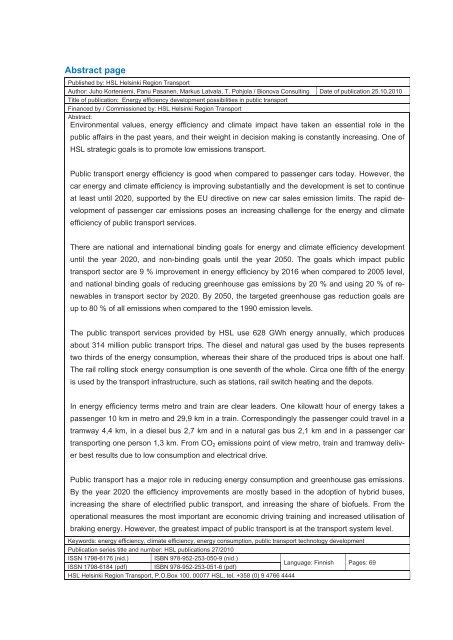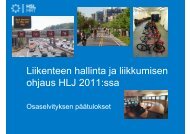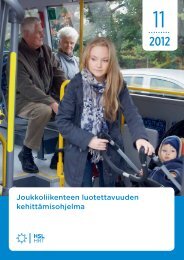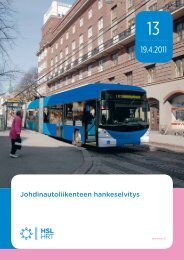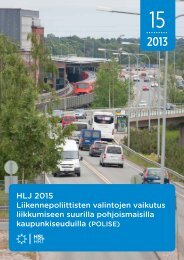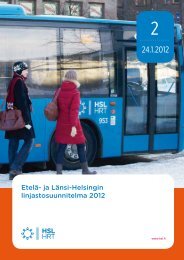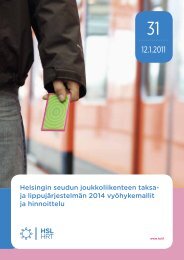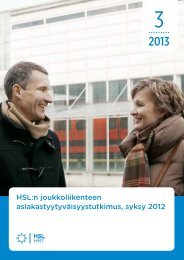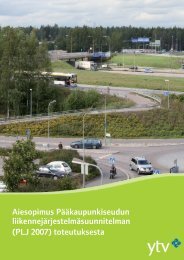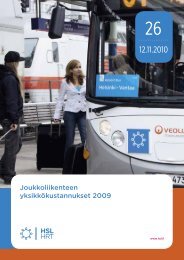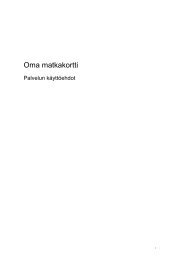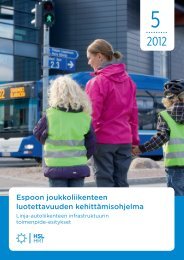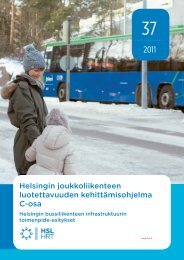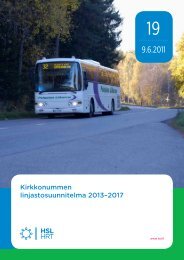Joukkoliikenteen energiatehokkuuden ... - HSL
Joukkoliikenteen energiatehokkuuden ... - HSL
Joukkoliikenteen energiatehokkuuden ... - HSL
Create successful ePaper yourself
Turn your PDF publications into a flip-book with our unique Google optimized e-Paper software.
Abstract page<br />
Published by: <strong>HSL</strong> Helsinki Region Transport<br />
Author: Juho Korteniemi, Panu Pasanen, Markus Latvala, T. Pohjola / Bionova Consulting Date of publication 25.10.2010<br />
Title of publication: Energy efficiency development possibilities in public transport<br />
Financed by / Commissioned by: <strong>HSL</strong> Helsinki Region Transport<br />
Abstract:<br />
Environmental values, energy efficiency and climate impact have taken an essential role in the<br />
public affairs in the past years, and their weight in decision making is constantly increasing. One of<br />
<strong>HSL</strong> strategic goals is to promote low emissions transport.<br />
Public transport energy efficiency is good when compared to passenger cars today. However, the<br />
car energy and climate efficiency is improving substantially and the development is set to continue<br />
at least until 2020, supported by the EU directive on new car sales emission limits. The rapid development<br />
of passenger car emissions poses an increasing challenge for the energy and climate<br />
efficiency of public transport services.<br />
There are national and international binding goals for energy and climate efficiency development<br />
until the year 2020, and non-binding goals until the year 2050. The goals which impact public<br />
transport sector are 9 % improvement in energy efficiency by 2016 when compared to 2005 level,<br />
and national binding goals of reducing greenhouse gas emissions by 20 % and using 20 % of renewables<br />
in transport sector by 2020. By 2050, the targeted greenhouse gas reduction goals are<br />
up to 80 % of all emissions when compared to the 1990 emission levels.<br />
The public transport services provided by <strong>HSL</strong> use 628 GWh energy annually, which produces<br />
about 314 million public transport trips. The diesel and natural gas used by the buses represents<br />
two thirds of the energy consumption, whereas their share of the produced trips is about one half.<br />
The rail rolling stock energy consumption is one seventh of the whole. Circa one fifth of the energy<br />
is used by the transport infrastructure, such as stations, rail switch heating and the depots.<br />
In energy efficiency terms metro and train are clear leaders. One kilowatt hour of energy takes a<br />
passenger 10 km in metro and 29,9 km in a train. Correspondingly the passenger could travel in a<br />
tramway 4,4 km, in a diesel bus 2,7 km and in a natural gas bus 2,1 km and in a passenger car<br />
transporting one person 1,3 km. From CO 2 emissions point of view metro, train and tramway deliver<br />
best results due to low consumption and electrical drive.<br />
Public transport has a major role in reducing energy consumption and greenhouse gas emissions.<br />
By the year 2020 the efficiency improvements are mostly based in the adoption of hybrid buses,<br />
increasing the share of electrified public transport, and inreasing the share of biofuels. From the<br />
operational measures the most important are economic driving training and increased utilisation of<br />
braking energy. However, the greatest impact of public transport is at the transport system level.<br />
Keywords: energy efficiency, climate efficiency, energy consumption, public transport technology development<br />
Publication series title and number: <strong>HSL</strong> publications 27/2010<br />
ISSN 1798-6176 (nid.) ISBN 978-952-253-050-9 (nid.)<br />
Language: Finnish Pages: 69<br />
ISSN 1798-6184 (pdf) ISBN 978-952-253-051-6 (pdf)<br />
<strong>HSL</strong> Helsinki Region Transport, P.O.Box 100, 00077 <strong>HSL</strong>, tel. +358 (0) 9 4766 4444


